Lesson Plan
advertisement
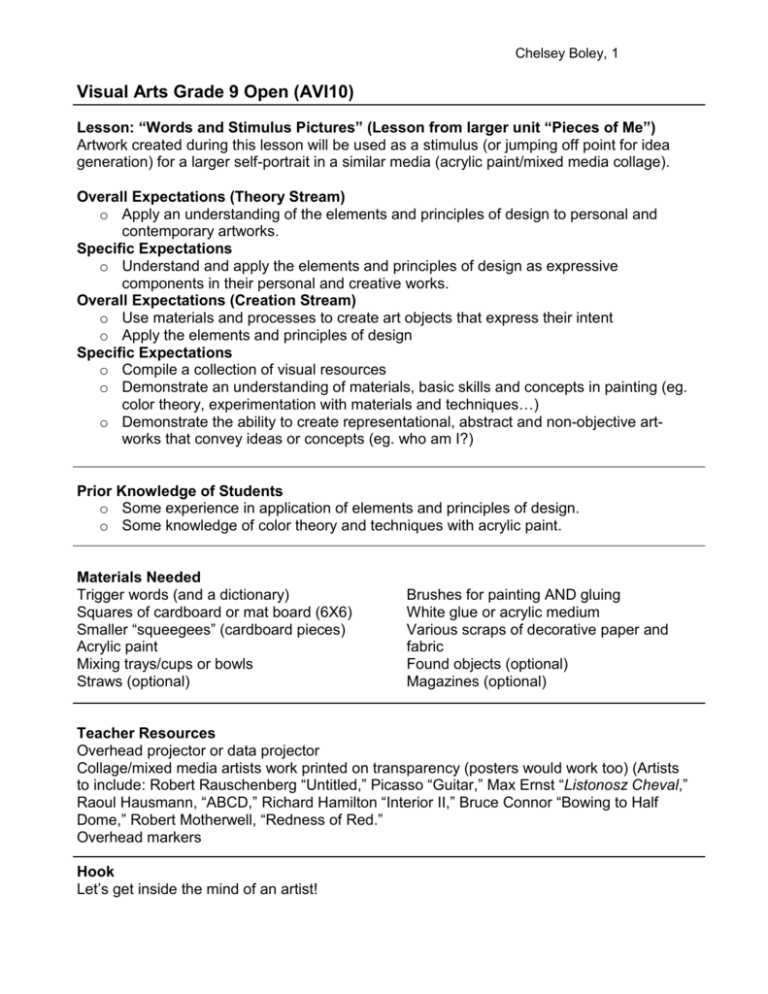
Chelsey Boley, 1 Visual Arts Grade 9 Open (AVI10) Lesson: “Words and Stimulus Pictures” (Lesson from larger unit “Pieces of Me”) Artwork created during this lesson will be used as a stimulus (or jumping off point for idea generation) for a larger self-portrait in a similar media (acrylic paint/mixed media collage). Overall Expectations (Theory Stream) o Apply an understanding of the elements and principles of design to personal and contemporary artworks. Specific Expectations o Understand and apply the elements and principles of design as expressive components in their personal and creative works. Overall Expectations (Creation Stream) o Use materials and processes to create art objects that express their intent o Apply the elements and principles of design Specific Expectations o Compile a collection of visual resources o Demonstrate an understanding of materials, basic skills and concepts in painting (eg. color theory, experimentation with materials and techniques…) o Demonstrate the ability to create representational, abstract and non-objective artworks that convey ideas or concepts (eg. who am I?) Prior Knowledge of Students o Some experience in application of elements and principles of design. o Some knowledge of color theory and techniques with acrylic paint. Materials Needed Trigger words (and a dictionary) Squares of cardboard or mat board (6X6) Smaller “squeegees” (cardboard pieces) Acrylic paint Mixing trays/cups or bowls Straws (optional) Brushes for painting AND gluing White glue or acrylic medium Various scraps of decorative paper and fabric Found objects (optional) Magazines (optional) Teacher Resources Overhead projector or data projector Collage/mixed media artists work printed on transparency (posters would work too) (Artists to include: Robert Rauschenberg “Untitled,” Picasso “Guitar,” Max Ernst “Listonosz Cheval,” Raoul Hausmann, “ABCD,” Richard Hamilton “Interior II,” Bruce Connor “Bowing to Half Dome,” Robert Motherwell, “Redness of Red.” Overhead markers Hook Let’s get inside the mind of an artist! Chelsey Boley, 2 Methodology (two periods of 75 minutes) 1. Introductory Discussion (15 minutes) o Begin with an inkblot picture on the overhead screen. Ask students how it makes them feel. This could be done informally with students saying the words as they come to them or with the “think, pair, share” method. Every single person should be able to come up with a word. This activity illustrates that through very, very simple means (just a few elements/principles of design) an emotion can be created. o Begin to repeat the process above but with various collage and mixed media artists’ works. Stress the “automaticness” of the process. The first feeling or word that comes to mind is the one that students should share. Progress to why the students think the work makes them feel this way. Through discussion, they can change their feeling words if they want. o Begin a discussion of artist’s intent: “Artists use specific elements and principles of design in order to make the viewer feel a certain way. We all might feel differently about a work, but the reasons we feel this way are all there in the artwork itself.” o Tell the students that they are going to create a small piece in the opposite way that we have just discussed: “Your intent (or feeling) will be given to you and it’s going to be your task to communicate it in an art piece.” 2. Choosing Words (7 minutes) o Students will each choose 3 or 4 from the words listed below. The words will be printed on slips of paper and put into a hat or bag. Once they each have 3 randomly chosen words they will have 5 minutes to find out what the words mean (if they don’t know) and make only one trade from the hat. They will make one small art piece from the one word they like the most. 3. Demonstration of Techniques (15 minutes) o Let students know that you’re going to show them a number of techniques to use, but these should not prevent them from doing some experimenting. Encourage students to take note in their sketchbook of techniques they think they would like to use in their pieces and to always have their words in mind. o Demo the following techniques in view of all of the students (possibly have them come to the front). o Paint Techniques: o Using the card “squeegees” to scrape paint across a surface o Dripping the paint onto a surface o Reminder of color theory o Collage Techniques: o Cutting edges vs. tearing edges o Effects with different types of paper and fabric o Photo-montage (if magazines included) 4. Generating Ideas (15 minutes) o Encourage the students to take the full 15 minutes to generate ideas about their words. See worksheet. Ask students to choose the word that they are going to use for completing their piece at this stage. 5. Begin Making Piece (20 minutes in first period, 75 minutes in second period) Chelsey Boley, 3 o Students will begin work on their piece. Students who finish their piece before the end of the 75 minute period will be encouraged to make an additional piece from one of their other words chosen. Evaluation Sketchbook Assignment Thinking/Inquiry (4 Marks) Level 1 Creative Uses creative thinking thinking skills with skills limited Flexibility effectiveness. and divergent thinking. Level 2 Uses creative thinking skills with moderate effectiveness. Creation (4 Marks) Level 1 Application of Applies the the creative creative process process with limited Striving for effectiveness. originality, exploring alternative approaches and answering the questions critically. Level 3 Uses creative thinking skills with considerable effectiveness. Level 4 Student uses creative thinking skills with a high degree of effectiveness. Level 2 Applies the creative process with some effectiveness. Level 3 Applies the creative process with considerable effectiveness. Level 4 Applies the creative process with a high degree of effectiveness and with confidence. Level 2 Demonstrates some understanding of elements and principles of design. Level 3 Demonstrates considerable understanding of relationships between concepts. Level 4 Demonstrates through and insightful understanding of relationships between concepts. Total (8 Marks) Small Piece Theory (8 Marks) Understanding of elements and principles of design. Level 1 Demonstrates limited understanding elements and principles of design. Chelsey Boley, 4 Communication (8 Marks) Level 1 Use of artistic The piece language and communicates symbols. How the trigger word effectively with limited does the piece accuracy and communicate effectiveness the trigger word? Level 2 The piece communicates the trigger word with some accuracy and effectiveness. Level 3 The piece communicates the trigger word with considerable accuracy and effectiveness. Level 4 The piece communicates the trigger word with a high degree of accuracy and effectiveness. Level 2 Transfers knowledge and skills to new contexts with moderate effectiveness. Level 3 Transfers knowledge and skills to new contexts with considerable effectiveness. Level 4 Transfers knowledge and skills to new contexts with a high degree of effectiveness. Creation (8 Marks) Transfer of knowledge and skills to new contexts. Are the techniques demonstrated evident? Level 1 Transfers knowledge and skills to new contexts with limited effectiveness. Total (24 Marks) Trigger Words Anguish, absurd, awake, austere, bedazzled, blah, calm, comfortable, confused, compassion, creepy, decadent, divided, delicate, dangerous, earthy, eclectic, excited, electric, elastic, enigmatic, fear, fatigue, fabulous, feminine, flimsy, foolish, foreign, glorious, graceful, gothic, heartsick, heavy, heroic, impatient, important, insightful, introverted, jealous, joyful, lion-hearted, love, logical, masculine, magical, manic, neutral, neurotic, optimistic, outraged, overzealous, panic, pacified, peachy, perfect, playful, poor, punch drunk, rage, rare, rich, suspicious, seedy, smooth, strong, surreal, truthful, terrible, tragic, uneasy, unmistakable, vacant, vacuum, vain, valid, welcome, yearning, zen.
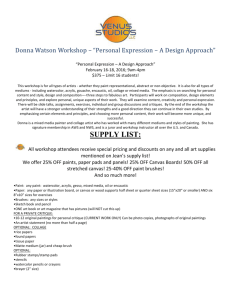


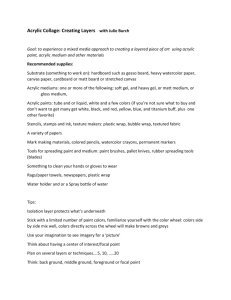
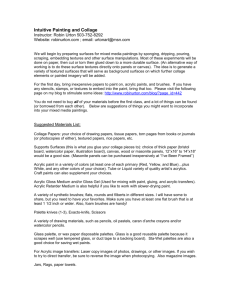
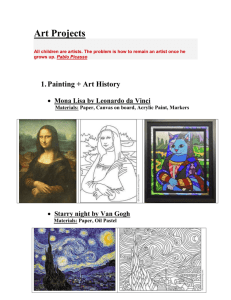
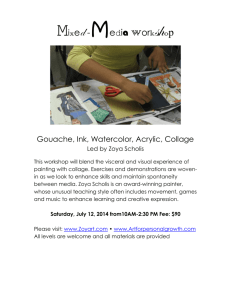

![[Agency] recognizes the hazards of lead](http://s3.studylib.net/store/data/007301017_1-adfa0391c2b089b3fd379ee34c4ce940-300x300.png)